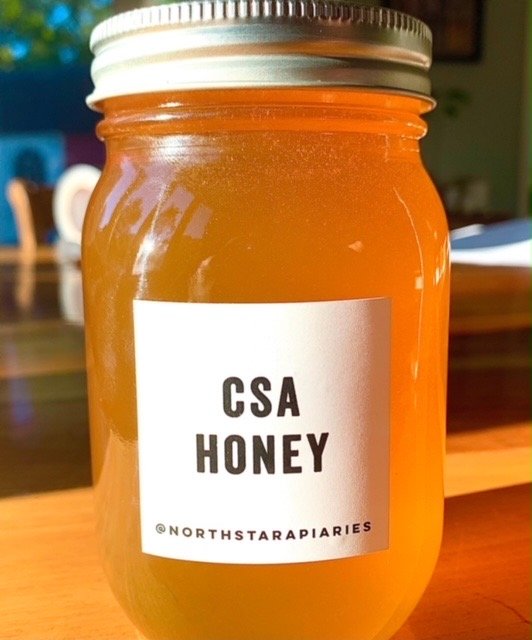Bees and Honey
Bee hives have been located on our farm since 2018. They are currently being managed by Derek Haars from Northstar Apiaries in Northfield, MN.
The bees spend their days foraging for pollen and nectar from the fields, forests and prairies on our farm and in the surrounding area. While helping to pollinate our crops they also produce delicious honey that Derek harvests in the fall. The honey is lightly filtered and minimally heated (which aids in bottling) to preserve the pollen, enzymes and other compounds naturally found in raw honey.
The beehives are kept on the farm all year. Derek is careful to manage the bees in such a way that they have honey and pollen reserves and are healthy enough to survive our harsh Minnesota winters. Derek also raises his own queens so that his bees are as hardy and well adapted to our region as possible.
Honey from the bees raised on our farm is available as a CSA add on in the fall. Each year’s honey crop is slightly different and is an expression of the unique flower blooms the bees encountered in a given year.
Cover crops
Cover crops are an important tool for improving soil health on our farm. Planted in our fields between vegetable crops, they help prevent soil erosion and suppress weed growth. Legumes, like clover, peas, and vetch, can also improve soil fertility by fixing nitrogen from the air into the soil. All cover crops increase organic matter which in turn improves soil structure and water retention, critical for dealing with the periods of extended dry or wet weather that are becoming more and more common. Ultimately, healthy crops need healthy soils, and cover crops are how we feed our soil.
Natural Spaces
We are committed to leaving wild spaces on our farm. From unmanaged wetlands to prairie restorations, our farm provides a space for more than just cultivated vegetables. These areas create habitat for microbes, insects, birds and other wildlife. They are critical to the overall health of our farm as they provide balance against the pests and diseases that affect our crops.
In 2017 we planted a half acre of flowering native plants with the help of the Xerxes Society. This planting provides a diverse array of flower blooms throughout the growing season, creating a buffet of pollen and nectar that supports all kinds of pollinators in the area.
Solar
In 2023 we installed a 37.5 kW solar array, large enough to offset all of our farm’s electrical use. We believe that calling ourselves a sustainable farm requires that we take concrete steps towards addressing the climate crisis. Our tractors still burn fossil fuels, but this goes a long way towards reducing our farm’s carbon footprint.




